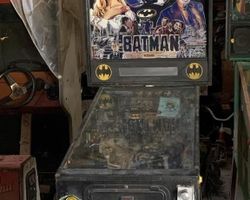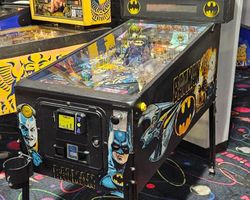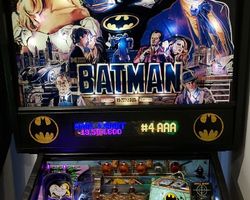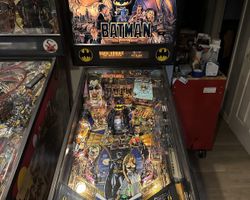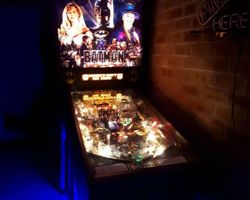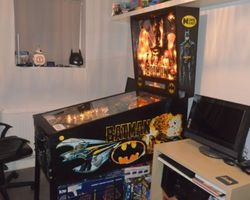Batman
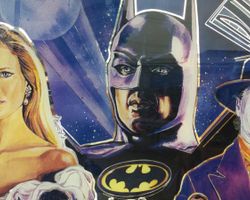
Average Prices: USD $600 to $2,300
Produced: July, 1991
Machine Type: Solid State Electronic
MPU: DataEast/Sega Version 3
Players: 4
Design by: Ed Cebula, Joe Kaminkow
Art by: Paul Faris, B. Farris, Todd Farris
Music by: Brian Schmidt
Sound by: Brian Schmidt
Software by: Kristina Donofrio, Neil Falconer, Harry Cline
The pinball machine Batman, released by Data East USA, Inc. in July 1991, brought the brooding atmosphere and iconic characters of the 1989 film directly to the arcade floor. With a production run of 3,500 units, manufactured from July to October 1991, this solid-state electronic (SS) machine captured the attention of both casual players and pinball enthusiasts through its thematic integration and technical advancements.
The creative forces behind Batman included designers Ed Cebula and Joe Kaminkow, who translated the cinematic vision into a playable experience. The visual appeal was largely due to the artwork by B. Farris, Paul Faris, and Todd Farris, whose detailed illustrations brought Gotham City to life on the playfield and backglass. On the technical side, software development was handled by Harry Cline, Kristina Donofrio, and Neil Falconer. A notable innovation was the sound system, with Brian Schmidt responsible for the music and sound design. Batman marked a significant milestone as the first pinball machine to employ the BSMT-2000 (Brian Schmidt Music Technology) Sound System, a pioneering audio platform that elevated the sonic experience of pinball. Voice characterizations, including those of Fred Young, further immersed players in the movie's narrative, with marketing slogans like "Wait 'Til They Get a Load of Me!" and "Insane Collections. No Joke." setting the stage for the chaotic fun within.
Signature Features and Design
Batman distinguishes itself through its direct integration of elements from the 1989 film, translating the dark aesthetic and character motifs into tangible playfield features. Central to its identity is the mirrored backglass and detailed cabinet artwork, which consistently draw praise for their faithful recreation of the movie's visual style. The game's sound design, powered by the BSMT-2000 system, is another defining element, featuring direct music cues and voice clips from the film, enhancing the thematic immersion.
Key interactive features on the playfield include the Batcave, represented by a prominent ramp that the ball travels through, acting as a pivotal shot. Another standout element is the Joker face, a diagonal plane situated in the upper left corner of the playfield. This feature incorporates three distinct holes – two representing the eyes and one the mouth – which become active targets during specific modes, notably "Laugh Mode." The Flugelheim Museum serves as a crucial lock area for initiating multiball, providing a distinct objective within the game's flow. These elements, combined with the game's vibrant lighting, work in concert to establish a compelling and recognizable Batman universe within the confines of the pinball machine.
Playfield and Mechanics
The playfield of Data East's Batman is configured with two flippers at the base, providing the primary means of ball control and shot execution. The layout incorporates a total of two ramps, three pop bumpers, and six drop targets, contributing to a diverse set of shot opportunities. A manual plunger initiates each ball, allowing for a skill shot opportunity to begin gameplay.
The Batcave ramp dominates the center of the playfield, serving as a high-value shot and a pathway for the ball. While accessible, its central placement has been noted by some players as occasionally segmenting the playfield or making certain shots feel obstructed. The second ramp, often referred to as the Joker Ramp, offers another main shot. The Joker face targets, integrated into the playfield's upper left, provide a unique interactive element during specific game modes, requiring precision aiming into the eye or mouth holes to advance objectives. The Flugelheim Museum area, positioned strategically, functions as the primary location for locking balls to initiate the game's three-ball multiball.
The design philosophy prioritizes accessibility, making the playfield layout straightforward for new players to grasp. The artwork and lighting scheme throughout the playfield reinforce the movie's aesthetic, with depictions of characters, scenes, and the urban grit of Gotham City. The color palette and visual motifs effectively capture the film's tone, enhancing player immersion through a cohesive visual presentation that complements the auditory experience provided by the BSMT-2000 sound system. Despite its relative simplicity in layout compared to later, more complex designs, the Batman playfield offers a blend of direct shots and themed interactions that align with its source material.
Gameplay Dynamics
Data East's Batman features a solid-state electronic (SS) system, specifically utilizing the Data East/Sega Version 3 MPU, which governs its gameplay mechanics and scoring. The core gameplay loop revolves around hitting key shots to advance through objectives and accumulate points. The rule set, while not overtly complex, provides clear goals for players.
A primary objective is to light and achieve the three-ball multiball, which is initiated by locking balls in the Flugelheim Museum. Once multiball is active, players aim for jackpots to maximize scoring. Beyond multiball, the game features distinct modes and challenges. "Laugh Mode" is activated by shooting into the specific holes on the Joker face, adding a theatrical, theme-driven objective. Other gameplay elements include scoring "Million Points," activating "Instant Multiball" under certain conditions, and achieving a "10x Bonus" for high-scoring opportunities. The manual plunger also allows for a skill shot, rewarding precise launches to specific targets at the game's start.
The sound package, with custom speech and snippets from the movie, complements the gameplay, providing immediate feedback and reinforcing the thematic atmosphere. The music, directly from the film's score, dynamically shifts with gameplay progression. While the straightforward rule set can make the game accessible to casual players, some experienced enthusiasts have noted that the clear objectives can lead to somewhat repetitive gameplay, where focusing on a few high-scoring shots, such as repeatedly hitting the Batcave ramp, can become a dominant strategy. However, for those seeking a fun and thematic experience without overly intricate rules, the game offers immediate engagement and a satisfying sense of progression, especially during its energetic multiball phases.
Reception and Legacy
Upon its release, Data East's Batman garnered a mixed yet generally positive reception from the pinball community. Its primary strength, widely acknowledged, was its faithful and engaging integration of the 1989 Batman film theme. Players frequently praised the machine's artwork, particularly the mirrored backglass and playfield graphics, for effectively capturing the movie's dark and stylized aesthetic. The sound package, enhanced by the BSMT-2000 system and featuring direct quotes and music from the film, also received acclaim for its immersive quality, further cementing the thematic connection. For casual players and fans of the movie, the game was often described as easy to understand and fun to play, offering straightforward rules and clear shot objectives that facilitated immediate enjoyment. The Batcave ramp, the interactive Joker face, and the Flugelheim Museum multiball were consistently highlighted as popular features.
However, the machine was not without its criticisms. The most common feedback pointed to a perceived lack of depth and replayability for seasoned players. The rule set, while accessible, was sometimes deemed too simple, leading to gameplay that could feel repetitive after extended sessions. Some players found that certain shots, such as the Batcave ramp, were too easy to hit repeatedly, allowing for exploitable scoring strategies that diminished the long-term challenge. The playfield layout itself also drew some criticism, with the central Batcave ramp occasionally noted for segmenting the playfield or creating "dead-end" shot angles. Additionally, while the sound was generally praised, some found the repetition of certain callouts, particularly the Joker's laugh, could become tiresome. The Dot Matrix Display (DMD) was also a point of contention for some, who desired more intricate animations.
Despite these critiques, Batman holds a distinct place in pinball history. Its pioneering use of the BSMT-2000 sound system set a new standard for audio fidelity in pinball, influencing subsequent machine designs across the industry. The machine demonstrated Data East's capacity for effectively utilizing licensed themes, laying groundwork for future cinematic adaptations in pinball. It remains a nostalgic centerpiece for fans of the 1989 film and an accessible entry point for new players into the hobby. While later machines would push boundaries in rule complexity and mechanical sophistication, Batman by Data East is remembered for its strong thematic presentation and approachable gameplay, securing its position as a recognizable and enjoyable machine within the larger pinball landscape.
Sponsored Links
 Ebay Listings
Ebay Listings
 Auction Results
Auction Results
| Cost | Location | Date |
|---|---|---|
| USD $1,280 |  Kentucky, United States Kentucky, United States |
28 August, 2025 |
| USD $11,495 |  Texas, United States Texas, United States |
08 August, 2025 |
| GBP £1,400 |  Chester, United Kingdom Chester, United Kingdom |
27 June, 2025 |
| USD $2,900 |  Pennsylvania, United States Pennsylvania, United States |
24 February, 2024 |
| USD $3,100 |  New York, United States New York, United States |
25 July, 2023 |
| USD $4,595 |  Colorado, United States Colorado, United States |
01 July, 2023 |
| USD $3,995 |  California, United States California, United States |
02 February, 2023 |
| GBP £2,900 |  Nottingham, United Kingdom Nottingham, United Kingdom |
15 November, 2021 |
| USD $2,200 |  Texas, United States Texas, United States |
04 October, 2021 |
| AUD $6,000 |  Victoria, Australia Victoria, Australia |
23 April, 2021 |


Private Policy · Search Website · Contact Us
As an eBay Partner, we may earn a commission from qualifying purchases made through links on this site, at no additional cost to you.
All trademarks and copyrighted materials remain property of their respective owners. All other content copyright 2007 - 2025 Pinpedia.

